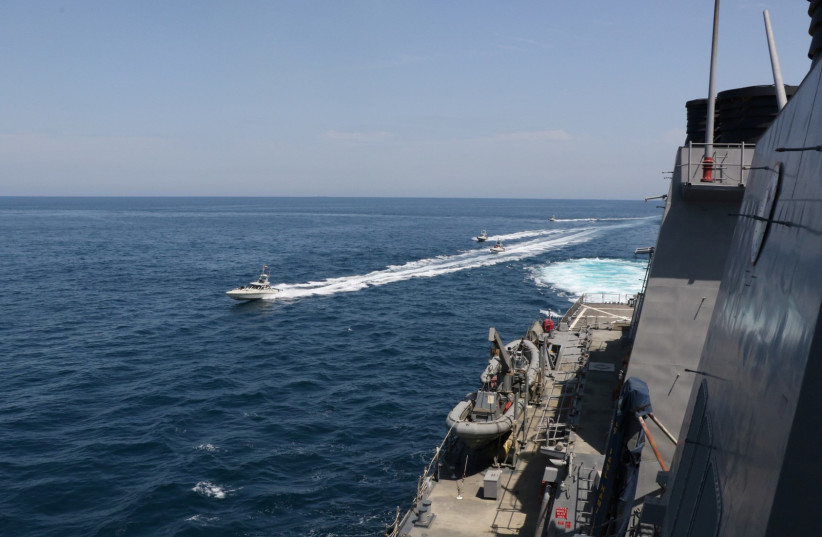The commander of the US Navy’s 5th Fleet and counterparts from the UK and France travelled on the USS Paul Hamilton destroyer through the Strait of Hormuz in a show of strength on Friday. The naval trip took place after Iran had seized two tanker ships recently.
The goal of the trip is to show that the straits are open and there is freedom of navigation. Historically the US, UK and France have been the key major naval powers that also operate in the Gulf, even though they operate here far from home.
According to the US Navy, V.-Adm. Brad Cooper “was joined by Joint Commander of the French Forces Deployed in the Indian Ocean V.-Adm. Emmanuel Slaars and United Kingdom Maritime Component Commander Commodore Philip Dennis. While aboard, the leaders met with Paul Hamilton leadership, observed patrol operations and thanked crew members for their efforts.”
Cooper said that “the Paul Hamilton team is doing remarkable work as we step up our patrols with regional allies and partners... This effort is about enhancing our collective vigilance and presence.”
“During the transit through the narrow strait, Paul Hamilton and UK Royal Navy frigate HMS Lancaster (F 229) passed one another as Cooper, Slaars and Dennis observed. Lancaster arrived in the region last year and recently seized 3,000 kg. of hashish worth $6 million from a fishing vessel transiting the Arabian Sea, May 8,” the US Navy said.

Historic military involvement in the Gulf
The history of the involvement in the Gulf by these navies goes back many decades, and Britain has had various naval presences in the Gulf and what is now Yemen since the 19th century. The power of the British navy gave way to a larger US presence over time, especially after the 1970s.
In the 1980s, the US participated in escorting ships during the so-called “tanker war” between Iran and Iraq. In the 1990s the US helped liberate Kuwait after Saddam’s invasion and in recent decades the US has had important naval operations out of Bahrain, and air force operations from bases in the UAE and Qatar.
Iran has increased its attacks on shipping since 2019, it has mined ships in the Gulf of Oman and used drones to attack ships and has seized numerous tankers from various countries. The Associated Press noted that “the Mideast-based commanders of the US, British and French navies transited the Strait of Hormuz on Friday aboard an American warship, a sign of their unified approach to keep the crucial waterway open after Iran seized two oil tankers.”
The significance of the trip through the Gulf
This decision by the US, France and UK is seen as a rare joint trip by key commanders. They travelled on the USS Paul Hamilton, an Arleigh Burke-class destroyer, and reports said that the IRGC sent three fast boats to monitor the ship. The Paul Hamilton was launched in 1993. The Associated Press noted that “while the [Islamic Revolutionary] Guard kept its distance from both the Paul Hamilton and the passing British frigate HMS Lancaster, their presence showed just how tense passage for vessels can be in the Strait of Hormuz, the narrow mouth of the Gulf through which a fifth of global oil supplies passes.”
Cooper noted that Iran has seized or attacked 15 ships in the last two years. Iran has also had proxies carry out around 80 attacks on US forces in Syria since 2021 according to a different report.
“The shipping industry is mindful of what the security posture looks like in the region. We have the ability to positively impact that influence and that’s what we’re doing now,” Cooper said. Asserting freedom of navigation such as the US is doing in the Gulf has been a key US policy for more than 100 years. The US Great White Fleet, the first modern naval fleet that America built, circumnavigated the globe in the early years of the last century, and freedom of navigation has been a cornerstone of policies the US pursued during the First World War and after.
Cooper said Iran’s IRGC ships Friday came within 900 meters of the Paul Hamilton, which is based out of San Diego.
The AP report noted that “on the trip through the Strait of Hormuz, at least one Iranian drone watched the Paul Hamilton. Meanwhile, a US Navy Boeing P-8 Poseidon also was overhead. US forces also routinely fly drones in the region as well, while a navy task force also has put some drones out to sea.”
The US is doing other important work to provide security in the Gulf. The 5th fleet has been seeking to use more unmanned vessels, basically naval drones on the water. The US 5th Fleet established Task Force 59 to help roll out some 100 of these unmanned vessels. These can do patrol and also do anti-mining operations and other types of operations.
